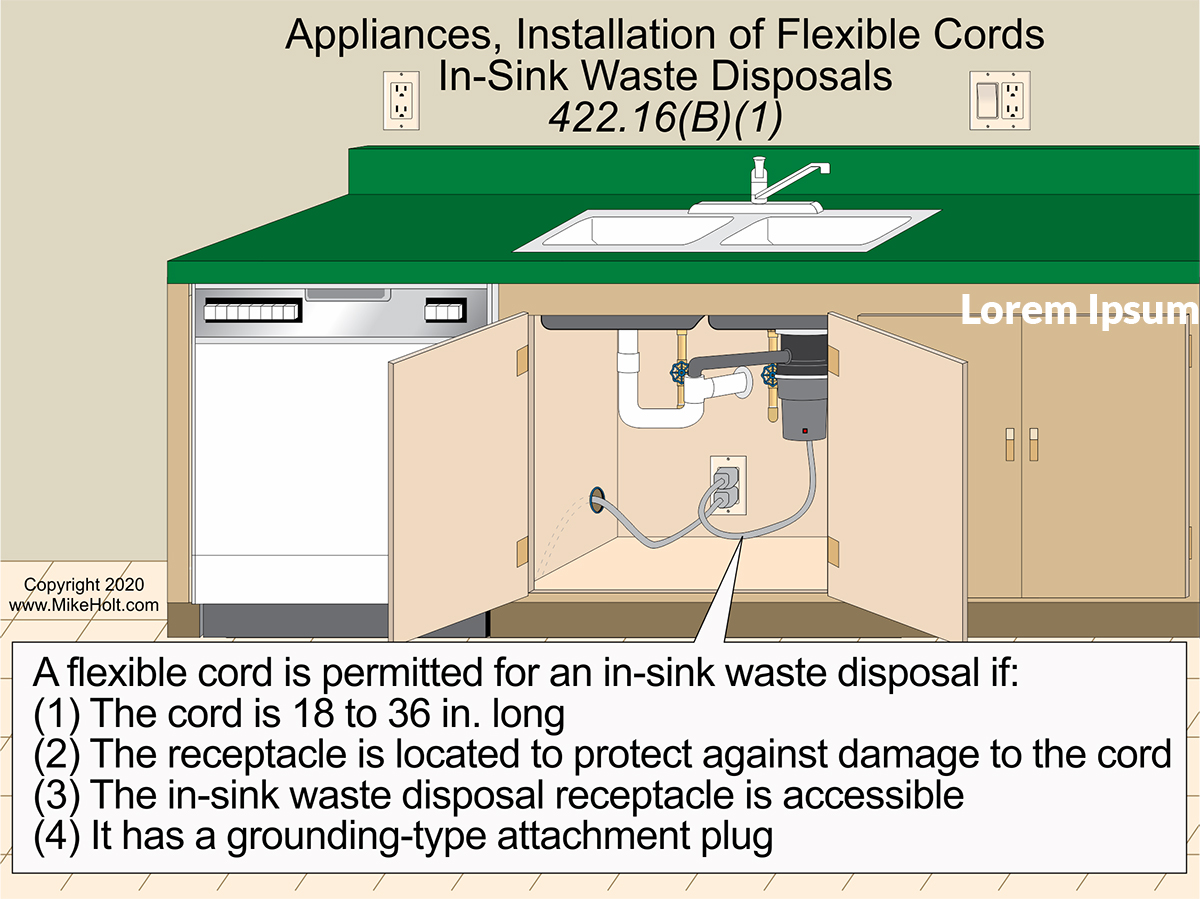|
For EC&M Magazine
By Mike Holt, NEC® Consultant
Here's the follow-up to yesterday's newsletter.
This includes the answers to the questions sent, so you can see how you did.


Figure 01
|
 |
|
Figure 01
|
For EC&M Magazine
By Mike Holt, NEC® Consultant
Here's the follow-up to yesterday's newsletter.
This includes the answers to the questions sent, so you can see how you did.

Note: The answers to these questions are based on the 2020 NEC.
Q1. What are the Code requirements for using a flexible cord to connect an in-sink waste disposal?
A1. Specific Appliances [422.16(B)]
(1) In-Sink Waste Disposal. A flexible cord is permitted for an in-sink waste disposal if: Figure 01
(1) The flexible cord is at least 18 in. in length and no longer than 3 ft
(2) The receptacle is located so as to protect the flexible cord from damage.
(3) The receptacle is accessible.
(4) The flexible cord has an equipment grounding conductor and is terminated with a grounding-type attachment plug.
Ex: A listed appliance distinctly marked to identify it as protected by a system of double insulation is not required to be terminated with a grounding-type attachment plug.
Q2. What is the Code rule regarding disconnects for permanently connected appliances?
A2. Appliances Rated Not Over 300 VA. Hard-wired appliances rated not over 300 VA or 18 hp, the branch-circuit overcurrent device is permitted to serve as the disconnecting means where the switch or circuit breaker is within sight from the appliance or is capable of being locked in the open position in accordance with 110.25 [422.31(A)]
Appliances Rated Over 300 VA. Hard-wired appliances rated over 300 VA must have a disconnect located within sight from the appliance or the disconnect must be capable of being locked in the open position in accordance with 110.25 [422.31(B)].
Author's Comment:
â–ºIf the appliance is hard wired, then the appliance disconnect must be located within sight from the appliance or circuit breaker for the appliance and must be lockable with provisions for locking to remain in place whether the lock is installed or not [422.31(A) or (B)].
â–ºAccording to Article 100, Within Sight means that it is visible and not more than 50 ft from the location of the equipment.
Q3. What is the NEC requirement for the minimum size of branch circuit conductors for fixed electrical space heating equipment?
A3. The branch-circuit conductors for fixed electric space-heating equipment and any associated motors must be sized not smaller than 125 percent of the load [424.4(B)].‚
Author's Comment:
â–ºThe branch-circuit conductors and overcurrent protection for fixed electric space-heating equipment must have an ampacity not less than 125 percent of the total heating load [210.19(A)(1) and 210.20(A)].
Example
Question: What size NM cable and overcurrent protection are required for a 9,600W, 240V fixed electric space heater that has a 3A, 240V blower motor? ‚
(a) 10 AWG/30A (b) 8 AWG/40A
(c) 6 AWG/50A (d) 6 AWG/60A
Answer: (d) 6 AWG/60A
Solution:
Step 1:‚Determine the total load.
I = Watts/Volts
I = 9,600W/240V
I = 40A
Total Amperes = 40A (heat) + 3A (blower)
Total Amperes = 43A
Step 2:‚Size the conductors at 125 percent of the total current load [424.4(B)].
Conductor = 43A × 125%
Conductor = 53.75A, use 6 AWG rated 55A at 60°C 1 [10.14(C)(1)(a)(2), 334.80, and Table 310.16]
Step 3:‚Size the overcurrent protection at 125 percent of the total current load [210.20(A), 240.4(B), and 240.6(A)].
Overcurrent Protection = 43A × 125%
Overcurrent Protection = 53.75A, use next size up: 60A
Q4. What is the Code rule for sizing disconnecting means for fixed electric space heating equipment?
A4. Heating equipment must have a means to simultaneously disconnect all circuit phase conductors [424.19].
(B) Heating Equipment Without Supplementary Overcurrent Protection. The disconnect for fixed heating equipment must be located within sight from the fixed heating equipment or it must be capable of being locked in the open position with provisions for locking to remain in place whether the lock is installed or not in accordance with 110.25.
(C) Unit Switch as Disconnecting Means. A unit switch on fixed electric heating equipment with a marked off position can serve as the required disconnect.‚
Q5. What is the NEC rule regarding protection of electric heating cables in concrete or masonry floors?
A5. GFCI Protection. In addition to the requirements in 210.8, GFCI protection is required for electric space-heating cables embedded in concrete or masonry floors of bathroom areas, kitchens, and hydromassage bathtub locations [424.44(E)].
|

